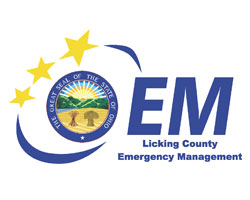Licking County Emergency Management Agency
Contact Us

Sean Grady -
MS, MSEM Director
John Wieber - OCEM, Deputy
Director
Office Phone:
Sean Grady- (740) 522-9031
John Wieber-(740) 522-9032
IF YOU HAVE AN EMERGENCY
CALL 911
Ohio Tornado Survivors: Apply for FEMA Assistance
Ohio homeowners and renters in Auglaize, Crawford, Darke, Delaware, Hancock, Licking, Logan, Mercer,
Miami, Richland and Union counties with disaster-related losses from the March 14 tornadoes may now call or go
online to apply for disaster assistance from FEMA.
If you have insurance coverage, first file a claim. If you have uninsured or underinsured losses, apply for FEMA
assistance by going online to DisasterAssistance.gov,
downloading the FEMA mobile app or calling the FEMA
Helpline at 800-621-3362. If you use video relay service, captioned telephone service or others, give FEMA your
number for that service. When calling the FEMA Helpline, multilingual operators are available (press 2 for Spanish
and 3 for other languages).
Federal assistance may include temporary lodging, basic home repairs and other disaster-related expenses.
Have the following information ready when you register with FEMA:
▪ A current phone number where you can be contacted
▪ Your address at the time of the disaster and the address where you are now staying
▪ Your social security number (or the social security number of a minor child in your household, if you’re
applying on their behalf)
▪ A general list of damage and losses
▪ Banking information if you choose direct deposit
▪ If insured, the policy number or the agent and/or the company name
Those who already made repairs or started their recovery should still apply.
FEMA inspectors are trained to recognize
damage caused by a disaster even after recovery has started, and they will discuss that damage with you when they
come to your home. Be prepared to show repair receipts, photos and any other disaster-related documentation as well.
EMA IS NOW ACTIVE WITH HYPER-REACH MNS. IT'S FREE TO SIGN UP AND IT TAKES LITTLE TIME TO REGISTER. PLEASE USE ONE OF THE FIVE WAYS TO REGISTER. ALWAYS BE PREPARED
|
5 Ways to Sign Up:
|
Licking County Emergency Management Agency
The Licking County Emergency Management Agency was established in 1988. It is an offshoot of the Civil Defense Program of the 1950's which later turned into Disaster Services. The Ohio Revised Code, Sections 5502.21 through 5502.99, forms the legal basis for the Emergency Management Agency. The Ohio Emergency Management Agency (OEMA) oversees Licking County EMA as well as the other 87 counties' EMA's. Under the guidelines and jurisdiction of the Federal Emergency Management Agency (FEMA), Ohio EMA gives Licking County the support and information it needs to take care of its population when disaster strikes.
The Licking County Emergency Management Agency is currently responsible for Homeland Security, the Regional Communications Center (911), and Safety Services operations within the County.
Licking County Emergency Management is located at 783 Irving Wick Dr. W, Heath, Ohio. The normal hours of operation are 7:30 am to 4:30 pm, Monday through Friday. The EMA Director and Deputy Director can be reached 24 hours a day, in case of an emergency by calling the 911 Center or by email.
Emergency Management runs the Emergency Operations Center (EOC) during crises. The EOC is designed to be the focal point of any response throughout the county. From this location we can use the Incident Command System (ICS) to help coordinate response and recovery efforts throughout the county.
The Management Team consists of a Director, Deputy Director, and the 911 Coordinator. In addition, there are approximately 45 CERT/ARES Volunteers as part of the Community Emergency Response Team. Emergency Management also works with partner agencies throughout the county in building and testing plans for the following:
- Emergency Operations Plan
- HazMat Response Plan
- Debris Management Plan
- Mass Fatality Plan
Just how does this all work? Primarily through the "Four Phases of Emergency Management: MITIGATION, PREPAREDNESS, RESPONSE AND RECOVERY.
MITIGATION: is any action taken to eliminate or reduce the degree of long-term risk to human life and property (including family pets) from any type of hazards. Some examples of mitigation are: building codes, public education, risk-area mapping, disaster insurance, tax incentives and statutes/ordinances/codes.
PREPAREDNESS: is any activity taken IN ADVANCE of an emergency that facilitates the implementation of a coordinated response. Some examples of preparedness are: hazard identification, emergency exercises, emergency operations' plans, emergency operations' centers, emergency broadcast systems sirens and continuity of government.
RESPONSE: is ANY action taken immediately before, during or directly after an emergency occurs, which saves lives, minimizes damage to property and enhances the effectiveness of recovery. Some examples of response are: activation of the Emergency Operations' Center (EOC), evacuation, emergency medical assistance, law enforcement response, emergency sheltering, fire and rescue response, and protective action announcements.
RECOVERY: is a short-term activity to return vital life-support systems to minimum operating standards and long term activity designed to return society to safe and normal levels of activity. Some examples of recovery are: damage assessment, decontamination, disaster assistance, reconstruction, debris clearance, counseling, and temporary housing.

